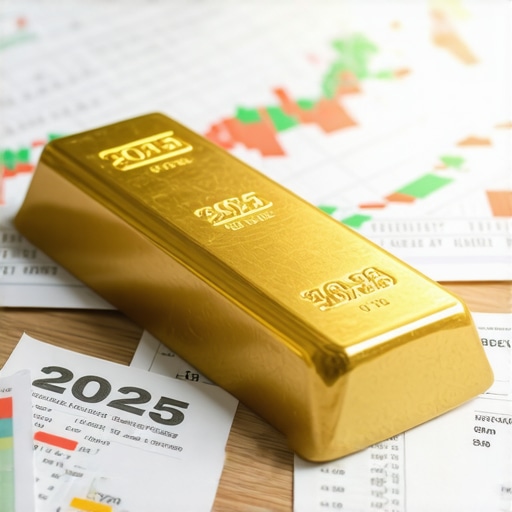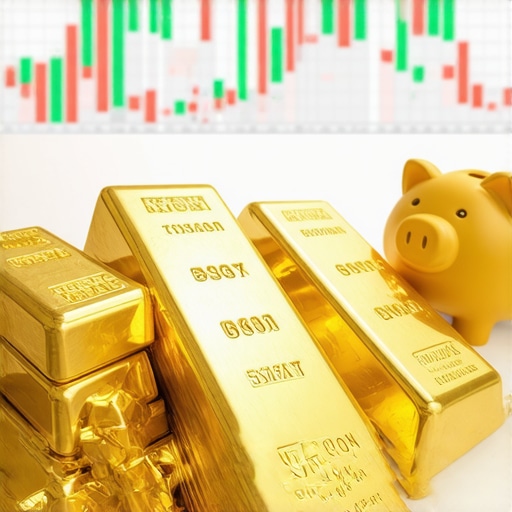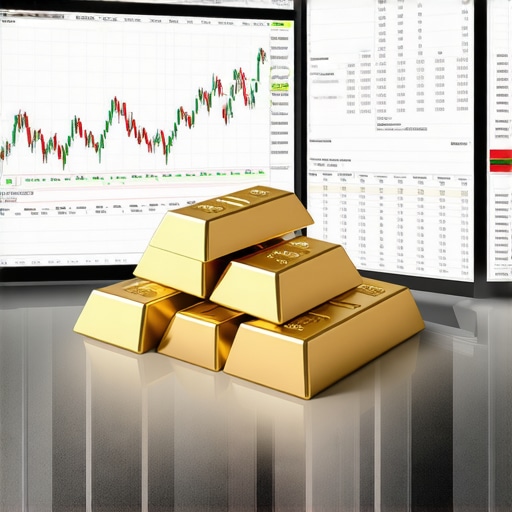Harnessing the Power of Gold ETFs & Mutual Funds for Diversified Wealth Growth in 2025
As the global economic landscape becomes increasingly complex and volatile, sophisticated investors are turning toward alternative assets to safeguard and expand their portfolios. Among these, gold Exchange-Traded Funds (ETFs) and mutual funds stand out as strategic instruments for achieving diversification, risk mitigation, and long-term wealth accumulation. In 2025, understanding the nuanced role of these investment vehicles is crucial for leveraging their full potential within a comprehensive asset allocation framework.
The Evolution of Gold Investment Vehicles in a Dynamic Market
Historically, physical gold investments—such as coins and bars—offered direct exposure but came with storage and security concerns. The advent of gold ETFs and mutual funds revolutionized access, allowing investors to gain exposure to gold’s price movements without the logistical burdens. These instruments are now deeply integrated into institutional and retail portfolios, reflecting a maturation of the gold investment ecosystem.
Expert-Level Perspective: Why Gold ETFs & Mutual Funds are Indispensable in 2025
In 2025, global macroeconomic factors—such as inflationary pressures, geopolitical tensions, and monetary policy shifts—continue to influence gold’s role as a safe-haven asset. Central bank gold acquisitions are notably impacting supply dynamics and price trajectories, underscoring the importance of sophisticated financial instruments like ETFs and mutual funds for precise exposure management.
These instruments also facilitate strategic asset allocation, enabling investors to balance risk-reward profiles efficiently. For instance, gold ETFs track spot prices with high liquidity, while mutual funds offer diversified exposure through actively managed portfolios that incorporate gold-related equities, futures, and derivatives, providing a layered approach to wealth preservation and growth.
Complex Questions for the Advanced Investor: How Do Supply-Demand Cycles and Price Drivers Interact to Influence Gold ETF Performance in 2025?
What are the key factors shaping gold supply-demand dynamics, and how do they translate into ETF and mutual fund price movements?
Expert analysis suggests that fluctuations in gold demand in jewelry, technology, and investment sectors combined with supply constraints—such as central bank sales or mine output—drive price volatility. These underlying fundamentals directly impact the valuation of gold ETFs and mutual funds, making them sophisticated tools for tactical positioning based on macroeconomic trends, geopolitical developments, and monetary policy signals.
Investors should integrate technical analysis and macroeconomic indicators—such as interest rate trajectories and inflation expectations—to optimize entry and exit points in gold-based funds, ensuring alignment with long-term strategic goals.
Leverage Expert Resources: Developing a Resilient Gold Investment Strategy for 2025
For those aiming to deepen their understanding, exploring comprehensive resources such as gold investment strategies and beginners’ guides can provide valuable insights into constructing a resilient portfolio. Engaging with financial advisors and participating in expert forums enhances strategic agility amid evolving market conditions.
In conclusion, mastering the interplay between macroeconomic fundamentals, supply-demand cycles, and investment vehicles such as gold ETFs and mutual funds is essential for astute investors in 2025. This layered approach not only enhances diversification but also fortifies portfolios against systemic risks, ensuring sustained growth in turbulent times.
Unlocking the Next Level: Advanced Strategies for Gold ETFs & Mutual Funds in 2025
As investors seek more sophisticated approaches to optimize their gold exposure, understanding the nuanced mechanics of gold ETFs and mutual funds becomes paramount. With macroeconomic uncertainties, geopolitical shifts, and evolving supply-demand dynamics, a deep dive into strategic positioning can significantly enhance portfolio resilience and growth.
How Do Macro Trends and Market Sentiments Shape Gold ETF Performance?
Could emerging economic indicators redefine the tactical deployment of gold funds in 2025?
Expert analysis underscores that macroeconomic variables—such as inflation rates, interest rate policies, and currency fluctuations—are critical in shaping gold ETF trajectories. For instance, rising inflation often drives demand for gold as a hedge, positively impacting ETFs tracking spot prices. Conversely, tightening monetary policies might suppress gold prices temporarily, creating opportunities for tactical entry. Staying abreast of market drivers and economic indicators allows investors to fine-tune their allocations for optimal risk-adjusted returns.
Furthermore, market sentiment and geopolitical developments—like trade tensions or regional conflicts—can lead to sudden shifts in gold demand, impacting ETF valuations. Incorporating sentiment analysis tools and macroeconomic models enhances decision-making precision, enabling investors to anticipate and respond to these complex influences effectively.
Leveraging Data-Driven Frameworks for Tactical Asset Allocation
Advanced investors increasingly rely on quantitative models and analytics to inform their gold investment decisions. Techniques such as machine learning-based trend forecasting, volatility modeling, and correlation analysis with other asset classes can uncover subtle market signals. For example, analyzing historical demand cycles across sectors reveals patterns that can inform entry and exit points for gold ETFs and mutual funds.
Additionally, employing risk management frameworks—like value-at-risk (VaR) and scenario analysis—helps in constructing resilient portfolios that withstand market shocks. Integrating these tools into a comprehensive strategy enhances the ability to capitalize on short-term opportunities while maintaining long-term growth trajectories.
What Are the Implications of Supply Constraints and Central Bank Policies?
How will ongoing central bank gold purchases and mine output fluctuations influence ETF liquidity and pricing in 2025?
In-depth research indicates that central bank acquisitions—detailed in resources such as market outlooks for 2025—continue to affect supply levels, potentially tightening available gold and elevating prices. These actions often lead to increased demand for gold ETFs as investors seek efficient exposure to a shrinking supply pool.
Simultaneously, mine output constraints due to geopolitical factors or environmental regulations can limit new gold supply, further boosting ETF valuations. Investors should monitor official reports and market analyses to anticipate supply-side shocks and adapt their holdings accordingly, leveraging insights from supply-demand trend reports.
In conclusion, integrating macroeconomic insights, data-driven analytics, and supply-demand fundamentals is essential for advanced investors aiming to maximize gains from gold ETFs and mutual funds in 2025. For those seeking practical guidance, exploring resources like gold investment strategies can provide actionable frameworks to refine your approach.
Share your thoughts or experiences with strategic gold investing in the comments below, and consider exploring more expert insights on how to build a resilient gold portfolio for 2025.
Deciphering the Interplay of Geopolitical and Economic Indicators on Gold ETF Dynamics in 2025
As we delve deeper into the complexities of the gold investment landscape in 2025, it becomes evident that geopolitical tensions, such as regional conflicts and trade disputes, intricately influence gold ETF valuations. These tensions often trigger risk aversion among investors, leading to surges in gold demand as a safe-haven asset. Concurrently, macroeconomic indicators like inflation rates, currency fluctuations, and interest rate policies serve as critical catalysts that either bolster or suppress gold prices.
For instance, an unexpected spike in inflation—detected through CPI reports—can drive institutional and retail investors toward gold ETFs, viewing them as a hedge against currency devaluation. Conversely, a hawkish stance by central banks, signaling rate hikes, might temporarily dampen gold’s appeal, creating tactical entry or exit points for savvy investors.
To navigate this volatile terrain, expert analysis recommends leveraging advanced economic models and sentiment analysis tools. These technologies synthesize real-time geopolitical developments with macroeconomic data, providing a nuanced understanding of potential market shifts. As noted by the World Gold Council (2024), such integrated analytical frameworks are vital for optimizing tactical asset allocation and mitigating systemic risks.
Unveiling the Hidden Dynamics of Gold Market Cycles in 2025
As the gold investment landscape evolves, understanding the intricate market cycles becomes paramount for sophisticated investors. These cycles, driven by macroeconomic shifts, geopolitical events, and technological advancements, influence the performance of gold ETFs and mutual funds in complex ways. Recognizing the transition phases—accumulation, markup, distribution, and markdown—allows investors to time their entries and exits with precision, optimizing risk-adjusted returns.
Can Advanced Quantitative Models Revolutionize Gold Portfolio Management?
Indeed, leveraging machine learning algorithms and big data analytics enables portfolio managers to decode subtle market signals previously obscured by traditional analysis. Techniques like neural networks for trend prediction, entropy-based volatility measures, and correlation matrices with macroeconomic indicators facilitate high-frequency adjustment of gold exposure. According to the World Gold Council’s recent report, integrating these tools significantly enhances tactical agility and resilience in turbulent markets.
How Do Geopolitical Shocks and Policy Shifts Interact with Supply-Demand Fundamentals?
Geopolitical shocks—such as regional conflicts or trade wars—often induce short-term surges in gold demand, impacting ETF liquidity and pricing. Simultaneously, policy shifts like quantitative easing or interest rate hikes by major central banks alter the macroeconomic backdrop, influencing investor sentiment and demand elasticity. Monitoring real-time supply-demand data and geopolitical risk indices enables proactive adjustment of gold allocations, ensuring portfolios remain resilient against systemic shocks.
What Are the Cutting-Edge Strategies for Hedging Currency Risks Using Gold Funds?
Advanced investors employ sophisticated hedging techniques—such as currency-hedged ETFs and options strategies—to mitigate risks arising from currency fluctuations. For instance, pairing gold ETFs with foreign exchange derivatives can neutralize adverse currency movements, preserving gains during volatile periods. Expert advice suggests integrating currency risk management frameworks into your broader asset allocation for enhanced stability and growth.
Engage with Leading Resources and Develop a Tactical Edge
To refine your strategies, explore authoritative sources like the World Gold Council’s comprehensive research and proprietary analytical tools. Collaborate with seasoned financial advisors specializing in precious metals, and participate in high-level investment forums focused on macro trends and quantitative methods. These engagements foster a nuanced understanding, enabling you to craft resilient and opportunistic gold investment strategies tailored for 2025 and beyond.
Expert Insights & Advanced Considerations
1. The Role of Macro Trends in Gold ETF Performance
Understanding macroeconomic variables such as inflation rates, interest policies, and currency fluctuations provides investors with predictive insights into gold ETF movements. Advanced models that incorporate real-time data and sentiment analysis can enhance tactical decision-making, allowing for more precise allocation adjustments in 2025.
2. Supply-Demand Fundamentals as Market Catalysts
Monitoring central bank gold acquisitions and mining output constraints is crucial. These supply-side factors often trigger significant price shifts, and integrating this intelligence into ETF strategies can optimize risk-adjusted returns amid evolving geopolitical and economic conditions.
3. Quantitative Models for Portfolio Resilience
Employing machine learning algorithms, volatility analyses, and correlation matrices with macroeconomic indicators enables sophisticated investors to decode subtle market signals. These tools support dynamic rebalancing of gold exposure, fostering resilience and growth in turbulent markets.
4. Geopolitical and Policy Shocks Impact
Real-time geopolitical developments, such as regional conflicts or trade tensions, significantly influence gold demand. Coupled with policy shifts like interest rate hikes, they create both risks and opportunities. Advanced analytics integrating geopolitical risk indices can guide strategic positioning in gold funds.
5. Currency Risk Hedging Strategies
Sophisticated investors utilize currency-hedged ETFs and derivatives to mitigate exchange rate volatility. Combining these with macroeconomic forecasts ensures stable gains and preserves portfolio value during periods of currency turbulence.
Curated Expert Resources
- World Gold Council Research: Offers comprehensive insights into market trends, supply-demand dynamics, and macroeconomic impacts, essential for informed decision-making.
- Gold Market Analysis Reports: Regular updates and predictive analytics on gold price drivers, supply constraints, and geopolitical factors from leading financial institutions.
- Quantitative Analytics Platforms: Tools like machine learning dashboards and volatility modeling software for developing data-driven investment strategies.
- Official Central Bank Reports: Vital for tracking gold purchase trends and supply forecasts, aiding strategic timing of ETF investments.
Final Expert Perspective
Mastering the interplay of macroeconomic fundamentals, supply-demand fundamentals, and quantitative analytics is paramount for advanced investors navigating gold ETFs & mutual funds in 2025. Leveraging these insights not only enhances diversification but also fortifies portfolios against systemic risks. Dive deep into authoritative resources and collaborate with financial experts to craft resilient, data-informed strategies. Your expertise and proactive engagement will define success in this dynamic landscape—share your insights or explore more at top gold investment strategies or central bank gold outlooks.”},









